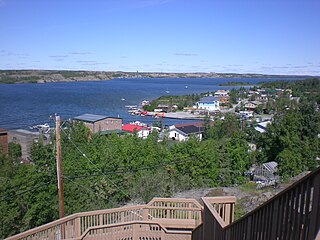
The Northwest Territories is a federal territory of Canada. At a land area of approximately 1,144,000 km2 (442,000 sq mi) and a 2016 census population of 41,786, it is the second-largest and the most populous of the three territories in Northern Canada. Its estimated population as of 2020 is 44,904. Yellowknife became the territorial capital in 1967, following recommendations by the Carrothers Commission.

Yellowknife is the capital, only city, and largest community in the Northwest Territories, Canada. It is on the northern shore of Great Slave Lake, about 400 km (250 mi) south of the Arctic Circle, on the west side of Yellowknife Bay near the outlet of the Yellowknife River.

Enterprise is a hamlet in the South Slave Region of the Northwest Territories, Canada, located between Great Slave Lake and the Alberta border on the Hay River.

The Legislative Assembly of the Northwest Territories, or Legislative Council of the Northwest Territories, is the legislature and the seat of government of Northwest Territories in Canada. It is a unicameral elected body that creates and amends law in the Northwest Territories. Permanently located in Yellowknife since 1993, the assembly was founded in 1870 and became active in 1872 with the first appointments from the Government of Canada.

Kitikmeot Region is an administrative region of Nunavut, Canada. It consists of the southern and eastern parts of Victoria Island with the adjacent part of the mainland as far as the Boothia Peninsula, together with King William Island and the southern portion of Prince of Wales Island. The regional seat is Cambridge Bay.

Fort Smith is a town in the South Slave Region of the Northwest Territories (NWT), Canada. It is located in the southeastern portion of the Northwest Territories, on the Slave River and adjacent to the Northwest Territories/Alberta border.

Franco-Ténois, originating from the acronym TNO of the French term for the Northwest Territories of Canada refers to the widespread community of francophones that reside in the Northwest Territories.
The Mackenzie Highway is a Canadian highway in northern Alberta and the Northwest Territories. It begins as Alberta Highway 2 at Mile Zero in Grimshaw, Alberta. After the first 4.0 km (2.5 mi), it becomes Alberta Highway 35 for the balance of its length through Alberta and then becomes Northwest Territories Highway 1.

The history of Northwest Territories capital cities begins with the purchase of the Territories by Canada from the Hudson's Bay Company in 1869, and includes a varied and often difficult evolution. Northwest Territories is unique amongst the other provinces and territories of Canada in that it has had seven capital cities in its history. The territory has changed the seat of government for numerous reasons, including civil conflict, development of infrastructure, and a history of significant revisions to its territorial boundaries.

The Yellowknife River is a river in the Northwest Territories, Canada. It flows south and empties into Yellowknife Bay, part of Great Slave Lake, at the city of Yellowknife. The lake is drained by the Mackenzie River into the Arctic Ocean as part of the largest drainage basin in Canada. The name of the river derives from the Yellowknives Dene, a First Nations people who have lived in the area for thousands of years.

Łutselkʼe, also spelt Łutsel Kʼe, is a "designated authority" in the North Slave Region of the Northwest Territories, Canada. The community is located on the south shore near the eastern end of Great Slave Lake and until 1 July 1992, it was known as Snowdrift, as the community lies near the mouth of the Snowdrift River.
The history of the Northwest Territories begins with the population of the region by First Nations peoples, and proceeds through the transformation of it into provinces and territories of the nation of Canada, including the modern administrative unit of the Northwest Territories. When Europeans settlers began to divide the continent, the Northwest Territories included much of the sparsely populated regions of what is now western Canada. Over time, the provinces of Alberta, Saskatchewan, and Manitoba were formed out of the territories. In 1898, the Yukon territory became a separate entity and in 1999 Nunavut was formed from the eastern section.
Fort Smith Region was a former Statistics Canada census division, one of two in the Northwest Territories, Canada. It was abolished in the 2011 census, along with the other census division of Inuvik Region, and the land area of the Northwest Territories was divided into new census divisions named Region 1, Region 2, Region 3, Region 4, Region 5, Region 6.
This timeline of Yellowknife history summarises key events in the history of Yellowknife, a city in the Northwest Territories, Canada.
The 17th Northwest Territories Legislative Assembly was established by the results of the 2011 Northwest Territories general election on October 3, 2011. It is the 25th sitting of the Assembly in the territories history. The Assembly was dissolved in 2015.

The following outline is provided as an overview of and topical guide to the Northwest Territories:
On March 21, the Northwest Territories reported its first case of COVID-19; the individual had travelled to British Columbia and Alberta before returning home to Yellowknife. The territory had declared a state of emergency on March 18.









